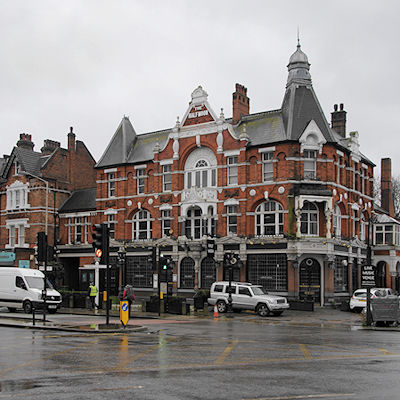
Like us on Facebook
PLACE NAMES


 
|
|
Herne Hill
|

|
|
Herne Hill is situated between the areas of Brixton, Dulwich Village and Camberwell. It also straddles two boroughs, and is a community of just under 12,000 people, with a range of independent shops, art galleries, bars and restaurants. The Southwark half of Herne Hill is part of what is now called the North Dulwich Triangle. Famous Herne Hill residents from history include John Ruskin and the Lupino family, and actor Roddy McDowall was born there.
In Rocque's 1746 map, the area is shown as "Island Green", probably reflecting the presence of the River Effra and smaller tributaries. Early references to the area also use the form "Ireland Green".
The earliest documented reference to "Herne Hill" is in two fire insurance policies issued by the Sun Insurance Company in 1792 (where the spelling is "Hearns" and "Herns" Hill).
The area now known as Herne Hill was part of the Manor of Milkwell, which existed from at least 1291, and was a mixture of farms and woodland until the late 18th century. It was divided between the ancient parishes of Camberwell and Lambeth. In 1783, Samuel Sanders (a timber merchant) bought the land now occupied by Denmark Hill and Herne Hill from the Manor; he then began granting leases for large plots of land to wealthy families.
By the mid-19th century, the road from the modern Herne Hill Junction to Denmark Hill was lined with large residential estates and the area had become an upper-class suburb (John Ruskin spent his childhood at an estate on Herne Hill).
Herne Hill was transformed by the arrival of the railways in 1862. Cheap and convenient access to London Victoria, the City of London, Kent and south-west London created demand for middle-class housing; the terraced streets that now characterise the area were constructed in the decades after the opening of Herne Hill station and the old estates were entirely built over.
The Half Moon is a Grade II* listed public house in Half Moon Lane.
Herne Hill escaped lightly from V-weapons attacks during World War II, with five V-1 flying bombs and six deaths recorded.
During the early morning of 7 August 2013, an 88-year-old 0.9 m diameter water main on Half Moon Lane burst, flooding Herne Hill, Dulwich Road and Norwood Road along with 36 properties (including the Half Moon public house) to create a scene described as "biblical" by local residents. The Half Moon remains closed, but there has been a vigorous local campaign for it to be reopened as a pub; Southwark Council have declared it an asset of community value.
The area is home to the 50.8 ha (125.5 acres) Brockwell Park. Near a hilltop in Brockwell Park stands the Grade II* listed Brockwell Hall, which was built in 1831. The hall and the land surrounding it were opened to the public in 1891 after being purchased by London County Council. Brockwell Park hosts the annual Lambeth Country Show and was the site of London's Gay Pride festival for several years in the 1990s. The park also houses Brockwell Lido, a 1937 open-air swimming-pool that faces on to Dulwich Road.
Herne Hill railway station on Railton Road was opened by the London, Chatham and Dover Railway in 1862; the Gothic, polychrome brick station building was Grade II listed in 1998. The associated railway viaduct and bridges are also noteworthy; The Building News stated in 1863 that the viaduct was "one of the most ornamental pieces of work we have ever seen attempted on a railway" for its fine brickwork.
The Herne Hill Velodrome, situated in a park off Burbage Road, was built in 1891 and hosted the track cycling events in the 1948 Summer Olympics. Unlike most modern, steeply-banked velodromes, it is a shallow concrete bowl; the 'Save the Herne Hill Velodrome' campaign is seeking a way to secure the future of the site. The same park also has a football pitch and was the home of Crystal Palace F.C. from 1915 until 1918.
A Blue Plaque at 84 Burbage Road marks the former home of the athletics coach Sam Mussabini. Mussabini was later immortalised in the film Chariots of Fire, in which he was played by actor Ian Holm. In 1894, Mussabini was appointed coach to the Dunlop cycling team which trained at the Herne Hill Velodrome. In 1913, Mussabini was appointed coach to the Polytechnic Harriers at the Herne Hill athletics track, which ran round the inside of the Velodrome cycle track. Here he trained athletes, including the fourteen-year-old Harold Abrahams.
The Half Moon Public House on Half Moon Lane was built in 1896 (although a tavern has existed on the site since at the 17th century) and was Grade II* listed in 1998. The pub hosted a boxing gym for more than 50 years.
The Church of St Paul on Herne Hill was originally built by G Alexander in 1843 but dramatically rebuilt by Gothic architect G E Street in 1858 after a destructive fire. It is now Grade II* listed.
The lake in Sunray Gardens (at the junction of Elmwood Road and Red Post Hill) was originally the fish pond in Casino House (a large estate established in 1796/97, now demolished); the adjoining Casino Estate still bears the house's name.
The Carnegie Public Library on the road now named Herne Hill Road opened in 1906 after a Lambeth Librarian got a grant from Andrew Carnegie for building a library within the Herne Hill area. It is also a listed Grade II building.
A Blue Plaque at 51 Herne Hill (by the junction with Danecroft Road) marks the former home of author Sax Rohmer (a.k.a. Arthur Henry Ward), most famous as author of the series of novels featuring the master criminal Dr. Fu Manchu.
|
 Feel free to Email me any additions or corrections Feel free to Email me any additions or corrections
LINKS AVAILABLE TO YOUR SITE
| |





